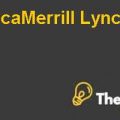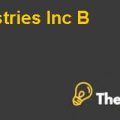ANSWER TO QUESTION # 1
In Exhibit 1, Overhead rates have been calculated for the model years 1987, 1988, 1989, and 1990 respectively. The overhead rate as a percentage of direct labor cost is calculated by dividing the total overhead expense for the year by total direct labor cost for that respective model year.
The calculations shows that the overhead rates as a percentage of direct labor cost, for the model years1987, 1988, 1989, and 1990 are 437%, 434%, 577%, and 563% respectively. The calculations shows a drastic increase in over -head rates between the model year 1988 and 1999. The calculation shows almost a 75% increase in the overhead rate of 1990 as compared to the overhead rate of 1989.
The reason for such increment in overhead rates is because in the model year 1989 the company has outsourced its two product lines, namely, Muffler/exhausts and oil pans. The company has outsourced these products because they are classified as class III products as per the evaluation criteria of the company.
This outsourcing resulted in declining sales as well as cost of the company. Because of outsourcing the direct labor cost for the model year 1990 has been decreased by 46% approximately as compared to last year, whereas, the total overhead cost for the model year 1990 decreased by approximately 28% as compared to previous year.
The total overhead cost acts as a numerator and total labor cost for the year acts as a denominator while calculating overhead rate as a percentage of direct labor. Thus, greater decrease in denominator as compared to numerator caused the overhead rate increase drastically.
ANSWER TO QUESTION # 2
In exhibit 2, gross margins of two products have been calculated separately for each year from 1988 to 1990. The gross margins has been calculated by subtracting direct material, direct labor and overhead costs, from the selling price of each products respectively.
Unlike overhead rates, the selling price, direct material cost, and direct labor costs are assumed to be same in all of the 3 years for both products. Whereas, the overhead rates calculated in exhibit 1for each year are used in calculating the gross profit margin of both the products separately in each year.
This calculation shows the effect of overhead rates on the gross margin of the product. The calculation shows that the gross marginsfor product 1 and product 2 for the year 1988 are 22% and 20% respectively. Whereas, the gross margins for product 1 and product 2 for the year 1989 are 9% and 12% respectively. This shows a dire change in the gross margins of the products.
The reason for decrease in gross margin of both the products in the year 1989 as compared to the gross margins of both products in the model year 1988 is because the overhead rates are high in 1989 as compared to the overhead rates of 1989. Increase in overhead rates caused increase in overhead cost which decreases the profit as well as gross margin of the product.
ANSWER TO QUESTION # 3
In exhibit 3, budgets have been made for the model year 1991. The budgets have been made under the following two scenarios
- There is no additional products are dropped, and the selling prices, volumes, and material costs will be the same as in model year 1990 for fuel tanks, doors and manifolds.
- The manifold product line is dropped, but the selling prices, volumes, and material costs will be the same as in model year 1990 for fuel tanks, and doors.
Bridgeton Industries Automotive Component & Fabrication Plant Case Solution
Exhibit 3 depicts that, in scenario 1, the company will earn the net profit of $63,766,000. Since the company is trying to maintain the cost efficiency in its operations, so it is assumed that the company is making effective strategies which is decreasing the overall cost of the operations of the company. Keeping this view in mind, it is wise to assume that the overhead costs are decreased in the model year 1991, as compared to the overhead costs of model year 1990.
Thus, decrease in overhead costs has increased the profit of the company for the model year 1991 as compared to the profit in the model year 1990. Not only, are the profits increased but also, the overhead absorption rate is also decreased for the model year 1991.......
...................
This is just a sample partial case solution. Please place the order on the website to order your own originally done case solution.











